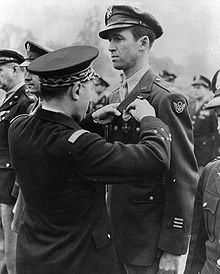Stewart was concerned that his expertise and celebrity status would relegate him to instructor duties "behind the lines."[40] His fears were confirmed when after his promotion to first lieutenant on July 7, 1942,[41] he was stationed from August to December 1942 at Kirtland Army Airfield inAlbuquerque, New Mexico, piloting AT-11 Kansans used in training bombardiers. He was transferred to Hobbs Army Airfield, New Mexico, for three months of transition training in the four-engine B-17 Flying Fortress, then sent to the Combat Crew Processing Center in Salt Lake City, where he expected to be assigned to a combat unit. Instead he was assigned in early 1943 to an operational training unit, the 29th Bombardment Group atGowen Field, Boise, Idaho, as an instructor.[35] He was promoted to captain on July 9, 1943,[41] and appointed a squadron commander.[36] For Stewart, now 35, combat duty seemed far away and unreachable and he had no clear plans for the future. However, a rumor that Stewart would be taken off flying status and assigned to making training films or selling bonds called for immediate action, because what he dreaded most was "the hope-shattering spectre of a dead end."[42] Stewart appealed to his commander, 30-year-old Lt. Col. Walter E. Arnold Jr., who understood his situation and recommended Stewart to the commander of the 445th Bombardment Group, a B-24 Liberator unit that had just completed initial training at Gowen Field and gone on to final training at Sioux City Army Air Base, Iowa.[43][N 4]
In August 1943, Stewart was assigned to the 445th Bomb Group as operations officer of the 703d Bombardment Squadron, but after three weeks became its commander. On October 12, 1943, judged ready for overseas movement, the 445th Bomb Group staged to Lincoln Army Airfield, Nebraska. Flying individually, the aircraft first flew to Morrison Army Airfield, Florida, and then on the circuitous Southern Route along the coasts of South America and Africa to RAF Tibenham, Norfolk, England. After several weeks of training missions, in which Stewart flew with most of his combat crews, the group flew its first combat mission on December 13, 1943, to bomb the U-boat facilities at Kiel, Germany, followed three days later by a mission to Bremen. Stewart led the high squadron of the group formation on the first mission, and the entire group on the second.[45] Following a mission to Ludwigshafen, Germany, on January 7, 1944, Stewart was promoted to major.[45][N 5] Stewart was awarded the Distinguished Flying Crossfor actions as deputy commander of the 2nd Combat Bombardment Wing on the first day of "Big Week" operations in February and flew two other missions that week.[47]
On March 22, 1944, Stewart flew his 12th combat mission, leading the 2nd Bomb Wing in an attack on Berlin. On March 30, 1944, he was sent to RAF Old Buckenham to become group operations officer of the 453rd Bombardment Group, a new B-24 unit that had just lost both its commander and operations officer on missions.[48] As a means to inspire the unit, Stewart flew as command pilot in the lead B-24 on several missions deep into Nazi-occupied Europe. As a staff officer, Stewart was assigned to the 453rd "for the duration" and thus not subject to a quota of missions of a combat tour. He nevertheless assigned himself as a combat crewman on the group's missions until his promotion to lieutenant colonel on June 3[41] and reassignment on July 1, 1944, to the 2nd Bomb Wing, assigned as executive officer to Brigadier General Edward J. Timberlake. His official tally of mission credits while assigned to the 445th and 453rd Bomb Groups totaled 20 sorties.
Stewart continued to make missions, uncredited, flying with the pathfinder squadron of the 389th Bombardment Group, with his two former groups, and with groups of the 20th Combat Bomb Wing.[49] He received a second award of the Distinguished Flying Cross for actions in combat and was awarded the Croix de Guerre. He also received the Air Medal with three oak leaf clusters. Stewart served in a number of staff positions in the 2nd and 20th Bomb Wings between July 1944 and the end of the war in Europe, and was promoted to full colonel on March 29, 1945.[41][50] On May 10, 1945, he succeeded to command of the 2nd Bomb Wing, a position he held until June 15.[51] Stewart was one of the few Americans to rise from private to colonel in four years.[10][35]


No comments:
Post a Comment